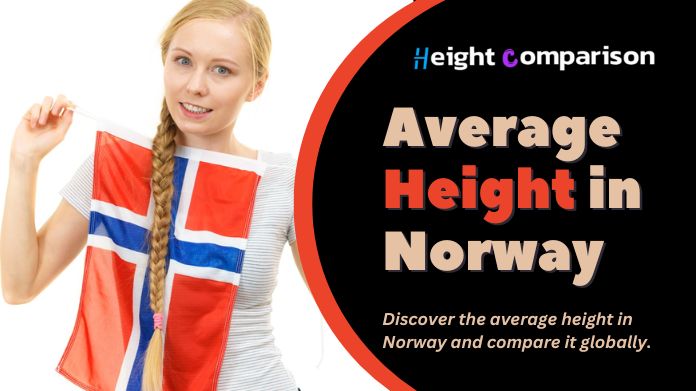The average height in Norway, known for its stunning landscapes and high living standards, reflects genetic factors and socio-economic conditions that contribute to health and well-being.
As one of the tallest populations globally, Norwegians have an average height that stands out internationally. Factors such as a nutritious diet, access to healthcare, and a generally active lifestyle contribute to this statistic.
This Height Comparison exploration into average height in Norway offers insights into the country’s societal norms, health outcomes, and genetic predispositions that shape physical attributes.
Understanding the average height in Norway provides a glimpse into the broader factors influencing population health and quality of life in this Scandinavian nation.
Average Height in Norway

The average height in Norway is noteworthy globally, with Norwegian males typically standing around 5 feet 10 inches (178 cm) tall, while females average about 5 feet 6 inches (167 cm).
These statistics place Norwegians among the tallest populations in the world. Factors contributing to this above-average height include:
Nutrition: Norwegians traditionally have access to a diet rich in seafood, dairy, and fresh produce, which supports healthy growth during childhood and adolescence.
Healthcare: The country’s universal healthcare system ensures access to regular check-ups, vaccinations, and treatments, contributing to overall health and well-being.
Lifestyle: A culture that values outdoor activities and physical fitness promotes healthy development and maintenance of stature.
Genetics: Norwegian genetics may also play a role, with inherited traits contributing to taller stature over generations.
Understanding Norway’s average height provides insights into the nation’s emphasis on health, well-being, and quality of life. It reflects a society committed to optimizing physical health and overall welfare.
| Age Group | Average Height (Male) | Average Height (Female) |
|---|---|---|
| 0-4 years | Data not commonly reported for this age group due to rapid growth | |
| 5-9 years | Boys: Around 115-130 cm | Girls: Around 112-127 cm |
| 10-14 years | Boys: Around 140-160 cm | Girls: Around 135-155 cm |
| 15-19 years | Boys: Around 170-180 cm | Girls: Around 160-170 cm |
| 20-29 years | Men: Around 178 cm | Women: Around 167 cm |
| 30-39 years | Men: Around 178 cm | Women: Around 167 cm |
| 40-49 years | Men: Around 178 cm | Women: Around 167 cm |
| 50-59 years | Men: Around 178 cm | Women: Around 167 cm |
| 60-69 years | Men: Around 178 cm | Women: Around 167 cm |
| 70+ years | Men: Around 175-177 cm | Women: Around 163-165 cm |
Are Norwegians Decreased in Height?
Norwegians are not known to be decreased in height. Norway has one of the tallest populations in the world. According to a 2016 study published in the journal eLife, Norwegian men have an average height of 179.74 cm (5 feet 10.8 inches), ranking them eighth tallest in the world.
Norwegian women have an average height of 165.56 cm (5 feet 5.1 inches), placing them fifth tallest globally. Historically, Norwegians have been among the tallest populations, particularly after rapid increases in average height during the 20th century.
This trend has been attributed to various factors, including improved nutrition, healthcare, and living conditions. It’s important to note that while Norwegians are, on average, taller than many other nations, height can vary significantly among individuals within the population.
How Tall Were the Viking Age Scandinavians?
During the Viking Age, Scandinavians were generally shorter than modern heights. Based on archaeological evidence and skeletal remains, the average height of Viking-age Scandinavians is estimated to have been around 5 feet 7 inches (170 cm) for men and slightly shorter for women, averaging around 5 feet 2 inches (158 cm).
Several factors contributed to these heights:
Nutrition: Diets during the Viking Age were primarily based on agriculture, fishing, and limited animal husbandry. While this diet was sufficient for survival, it may have provided a lower protein intake needed for optimal growth.
Healthcare: Medical knowledge and healthcare practices were rudimentary compared to modern standards, leading to higher rates of disease and infections that could affect growth and overall health.
Lifestyle: The physical demands of Viking life, such as manual labor, warfare, and harsh living conditions, could have impacted physical stature over generations.
It’s important to note that these estimates are based on skeletal remains and may vary across regions and social classes within Viking society. As with any historical population, individual variations in height would have existed among Viking Age Scandinavians.
Are Norwegians Still Tall These Days?
Without a doubt, sure. It is safe to conclude from the preceding paragraphs that Norwegians are tall. When it comes to height, Norwegians rank seventeenth in the world. The Netherlands holds the top spot with an average height of 5 feet 7.96 inches, or around 175.62 cm.
Instead, you will undoubtedly observe that Norwegians are taller than individuals from 180 other countries when you are standing next to them.
One more fascinating statistic about Norway’s height. Now that you know, not only are Norwegians incredibly tall, but several of the country’s birds are also the largest in their respective species. And among those largest species are eagles.
Conclusion
In conclusion, Norway’s status as one of the world’s tallest populations is a remarkable achievement, underscoring the country’s commitment to health, well-being, and quality of life.
The average height in Norway, influenced by factors like nutrition, healthcare accessibility, and genetic predispositions, is a testament to a society that has successfully prioritized physical health and overall wellness.
Beyond statistics, Norway’s tall stature symbolizes a population thriving in a prosperous and progressive environment where factors contributing to growth and development are optimized.
Norwegians enjoy robust health outcomes and high living standards; their average height is a testament to the country’s holistic approach to societal well-being and the enduring legacy of prioritizing health as a fundamental human right.






